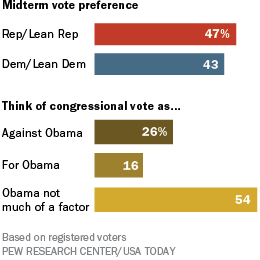As North Carolina Republicans go to the polls on Tuesday to choose a nominee to challenge Democratic Sen. Kay Hagan, the political terrain appears more and more treacherous for the Democrats heading into the fall midterm elections.
With the control of the Senate at stake, a maddening uneven economic recovery, an unpopular health care law, and President Obama’s persistently low standing in the polls are conspiring to undermine the Democrats’ outside chance of hanging onto the upper chamber and reducing the GOP majority in the House.
Related: A New Tidal Wave of Money Could Decide Senate Races
A national survey by the Pew Research Center and USA TODAY, conducted April 23-27 among 1,501 adults (including 1,162 registered voters), found that 47 percent of registered voters across the country support the Republican candidate in their district or lean Republican, while 43 percent favor the Democratic candidate or lean Democratic.
The trend over the past six months in the so-called generic ballot shows that Democrats have lost ground. In October, Democrats held a six-point lead (49 percent to 43 percent) in midterm voting preferences.
While a majority of voters (54 percent) say that Obama will not be a factor in their vote this fall, 26 percent see their vote as a blow against the president while only16 percent see it as a vote for the president. In February 2010, 24 percent of voters saw their vote as for Obama while about as many (20 percent) considered it a vote against him.
Pew’s findings are little different from other polls conducted in recent week, in which Obama looms as a major drag on the Democrats’ prospects this fall – in part because of the widespread unpopularity of his signature Affordable Care Act.
Related: Obama’s Falling Ratings Hurt Dems in Midterms
Obama’s overall job approval rating has shown virtually no change dating back to last December. Currently 44 percent of the public approve of the job he is doing as president while 50 percent disapprove, according to the Pew-USA TODAY poll.

In late April 2010, Obama’s job rating was slightly more positive than negative (47 percent approve, 42 percent disapprove). Obama’s rating varied little over the remainder of the campaign four years ago.
If it’s of any consolation to the White House, Obama’s current approval measure is much higher than that of former Republican President George W. Bush at this point in Bush’s 2006 midterm, and Obama is less of a drag on his party’s midterm prospects than Bush was.
In April 2006, Bush had a 35 percent job rating and twice as many voters considered their midterm vote as an expression of opposition to the president than as a signal of support (34 percent to 17 percent).
The latest survey was conducted before last Friday’s jobs report, which showed that the unemployment rate had fallen to 6.3 percent, its lowest level since 2008, and that the economy had added 288,000 jobs.
Related: Obamacare Update: Lots of Unanswered Questions
However, more than 800,000 people left the labor force. From the public’s point of view, jobs remain scarce: 65 percent say jobs in their community are difficult to find while 27 percent say there are plenty of jobs available.
Today’s election in North Carolina is being closely watched as Republicans choose a candidate to challenge Hagan, one of the most vulnerable Democratic Senate incumbents seeking another term. The high profile race has drawn a GOP field of nine candidates.
The top three GOP hopefuls in that race are state House Speaker Thom Tillis, Greg Brannon, a physician and Mark Harris, pastor at First Baptist Church of Charlotte. The latest poll gives Tillis 40 percent of the vote, the minimum needed to avoid a runoff election July 15. That same poll had Brannon with 28 percent and Harris with 15 percent.
Top Reads from The Fiscal Times:





